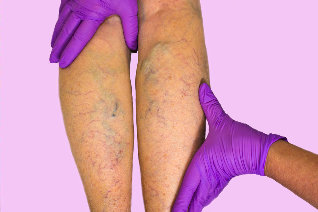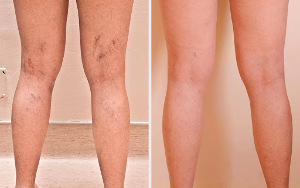It is a chronic vein disease, which is characterized by the thinning of their walls, the extension of the lumen and the formation of the nodes. Can be found in 40% of women and 20% men.
It is a dangerous disease, mainly because of its complications. Improper or delayed treatment of evolving as a formidable as thrombosis and thrombophlebitis, and bleeding from the varices. Thrombosis (partial or complete occlusion of the target vein by a blood clot) or thrombophlebitis (inflammatory disease of the vein wall in thrombosis) occurs suddenly, is not associated with physical activity. The swelling rapidly spreads in the lower limb, and accompanied by unbearable pain. Can occur redness or bruising, local tenderness of the skin. In the case of the separation of the clot from the blood, it gets into the blood vessels of the lungs, and in the event of a full or partial closure of a vessel, which can lead to serious illness - pulmonary embolism. This complication is frequently lethal. If you suspect that these complications, you should immediately take a horizontal position, lift the foot, over the telephone, you can contact the emergency medical assistance. When you damage the enlarged blood vessels, they can cause heavy bleeding. In this case, there is an urgent need to put in the leg above the bleeding tourniquet (a medical or improvised) is enough to ensure that the bleeding stops, immediately call an ambulance.
Thrombosis (partial or complete occlusion of the target vein by a blood clot) or thrombophlebitis (inflammatory disease of the vein wall in thrombosis) occurs suddenly, is not associated with physical activity. The swelling rapidly spreads in the lower limb, and accompanied by unbearable pain. Can occur redness or bruising, local tenderness of the skin. In the case of the separation of the clot from the blood, it gets into the blood vessels of the lungs, and in the event of a full or partial closure of a vessel, which can lead to serious illness - pulmonary embolism. This complication is frequently lethal. If you suspect that these complications, you should immediately take a horizontal position, lift the foot, over the telephone, you can contact the emergency medical assistance. When you damage the enlarged blood vessels, they can cause heavy bleeding. In this case, there is an urgent need to put in the leg above the bleeding tourniquet (a medical or improvised) is enough to ensure that the bleeding stops, immediately call an ambulance.
The weakness of the muscular layer of the venous wall and valvular incompetence can be a reason to influence the actions of the "muscle pump," the blood begins to flow in the opposite direction, down. This leads to an increased pressure on the walls of the blood vessels, and a further progression of the valve disease, enlargement of the lumen of the blood vessels and the nodules. The muscle fibers of vein walls to atrophy, disrupted by the nerve receptors, which regulate venous tone, which further enhances the manifestations of venous insufficiency. The risk factors for the development of the disease are: genetic predisposition, pregnancy, obesity, a day, for a long period of time sitting or standing, the activities associated with the lifting, the systematic wearing of tight garments, corsets, incorrect diet with insufficient intake of dietary fiber, and vitamins violations of hormonal status.
The clinical manifestations of
The main visible sign of the varicose disease - saccular or cylindrical dilation of the surface veins. Varicose veins of the legs become large, protrude above the surface of the skin in the legs and feet. Varices maximally expressed after a hard or long workout. In the early stages of the disease, the worry, the fatigue, the feeling of weight in the legs, burning, mild swelling, the severity of which the highest activity. You may experience temporary swelling, pain and pain along the vein. Timely access to a specialist is still at an early stage will prevent the subsequent development of the disease. With the progression of the disease, which is caused by chronic venous insufficiency.
The diagnosis of varicose veins
The "gold" standard is considered to be a diagnostic ultrasound of the veins of the lower extremities, which is set out in the affected areas of the blood vessels. This is a principle-based anatomic classification of varicose veins, with an indication of the modifying of the boat. For example, the defeat of the great saphenous vein above or below the knee, the small saphenous vein. When the questionable data to the non-invasive method of have resorted to surgical methods of investigation, e.g. venography (the injection of a contrast agent, to assess the status of the venous system).
The treatment of varicose veins
The non-surgical treatment of varicose veins of the lower limb give good results only in the early stages of the disease, when the skin manifestations are highly expressed in only a moderate reduction in the aptitude for the job.
This is a surgical disease, complete cure is possible only after the surgical treatment:
- Phlebectomy - surgical removal of the varicose-expanded veins. The aim of the operation was the elimination of the abnormal closure of the blood by the removal of the principal means of access to the large or the small saphenous vein and ligation of communication veins. There are many different types of surgery. They are applicable almost always, even in the most difficult situations. While all of these methods can remove part of the vein that is affected, and the healthy segments of the blood vessel is maintained. In vienna, as if carefully peeled, not cut from a cloth that also reduces surgical trauma. The same thing happens with the surgical technique, and, in addition, it creates less bruising, as the cold reduces spasm of the bleeding.
- Sclerotherapy - an introduction into a vein of a specific substance (sclerosant) which causes the "products" in the vein of the wall of the cessation of the flow of blood through it. The result of this is that there is an abnormal discharge of blood, eliminates the cosmetic defects, such as Vienna and perish, and become invisible. Sclerotherapy is effective only if it is an expansion of the small branches of the main trunks, which limits its application in high-severity exercise. The advantage of sclerotherapy is the lack of a scar, the need for hospitalization. After the hardening of the blood vessels of the specific rehabilitation is needed.
- Laser coagulation - this method, which is based on the destruction of the vein wall, with the warm of the laser exposure, resulting in a "spike" in the vein lumen. Only visible if the expansion vessel is not more than 10 mm. This method, which is associated with the anesthesia. Cosmetic advantage-but, according to the vein of the removal of the requirement of early activation of the patient, and the long-term elastic compression.












































